Simple Sautéed Swiss Chard
Who are my Swiss Chard lovers? If you love Swiss Chard you will fall head over heels for this Simple Sautéed Swiss Chard Recipe. If you are new this leafy green, prepare to fall for this delicious leafy vegetable, it is yummy and so easy to prepare!
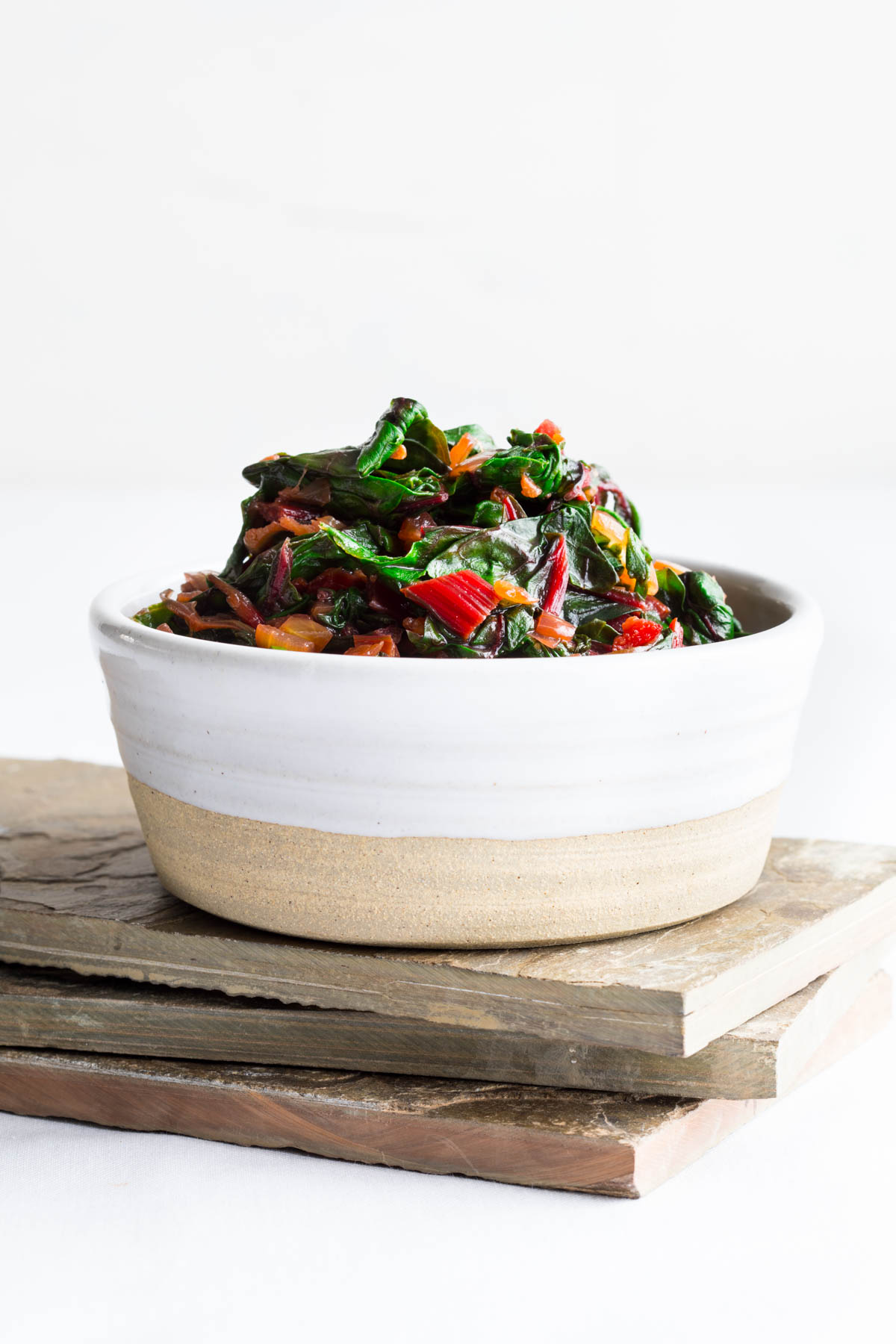
I originally shared this Swiss Chard recipe on November 19th, 2018. I have updated some of the text to share it with you again today.
Table of contents
Why You’ll Love This Swiss Chard Recipe
If you are stuck in the rut of baby spinach from a plastic box every week, it’s time to get on the Chard train! Don’t be intimidated by it, it’s not as scary as it looks and it is so good for you.
Chard is one of my favorite vegetables and I grow it in my vegetable garden every summer. In other words, I have cooked a lot of chard over the years! This recipe is my favorite way to cook chard and along with our Sauteed Green Beans, it is one of our most popular side dish recipes!
Loved this recipe. Very easy to prepare and delicious. Makes me want to eat chard often! Thank you!
~Penny
What is Swiss Chard?
Swiss Chard is a leafy vegetable that is related to beets. In fact it looks a lot like beet greens with bright red ribs and flat glossy green leaves. It has crunchy stems that are commonly red, though can also be white or yellow. The leaves range in color from dark green to reddish green. The flavor is similar to beets and spinach, with a slight bitterness, and a strong earthy flavor.
Swiss Chard is somewhat of a misnomer because it implies that it is a variety of chard from Switzerland. But actually, it is a general common name for chard and got the designation from the botanist who determined the plant’s scientific name in the 19th century. So to clarify, Swiss Chard and Chard are the same things.
Chard is a great green to add to your menu and can be used a big range of recipes. See more chard recipes here! But today’s tutorial is hands-down the best Swiss Chard recipe for those of you who are new to cooking with this super green.
Ingredients For This Swiss Chard Recipe
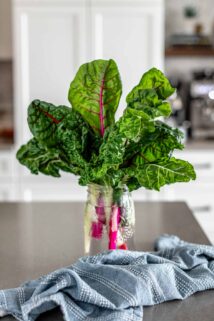
- Swiss Chard: Of course, the star of the show in this recipe is Swiss chard! You will need two large bunches of raw Swiss chard, which will yield about 6 cups of chard leaves plus stems. Note red chard, green chard and rainbow chard can be used interchangibly in this recipe.
- Olive Oil: To sauteé chard, start with your favorite cooking fat. I like olive oil or a high heat neutural oil like avocado oil or organic canola oil.
- Onions and Garlic: Since I am a total garlic lover I always add it to my leafy greens. When it comes to Swiss chard I also include sauteed diced onions. In my experience the sweetness of golden brown sauteed onions is key to this balancing the bitter taste of cooked chard. It is a great way to balance the earthy flavors of the chard and makes it very savory.
- Seasonings: For the seasonings, you’ll need salt, pepper and dry thyme. I also use a little ground nutmeg which compliments sauteed greens amazingly well and adds a delicate nuance.
- Balsamic Vinegar: While it may be counterintuitive to add vinegar to make it more palatable, the acidity in the vinegar balances the bitter taste in the chard and the overall effect is more harmonious.
TIP: If you are new to Swiss chard, or you just picked some up from the farmers market, make sure to check out our tutorial on how to cut and clean and store Swiss Chard.
How to Cook Swiss Chard
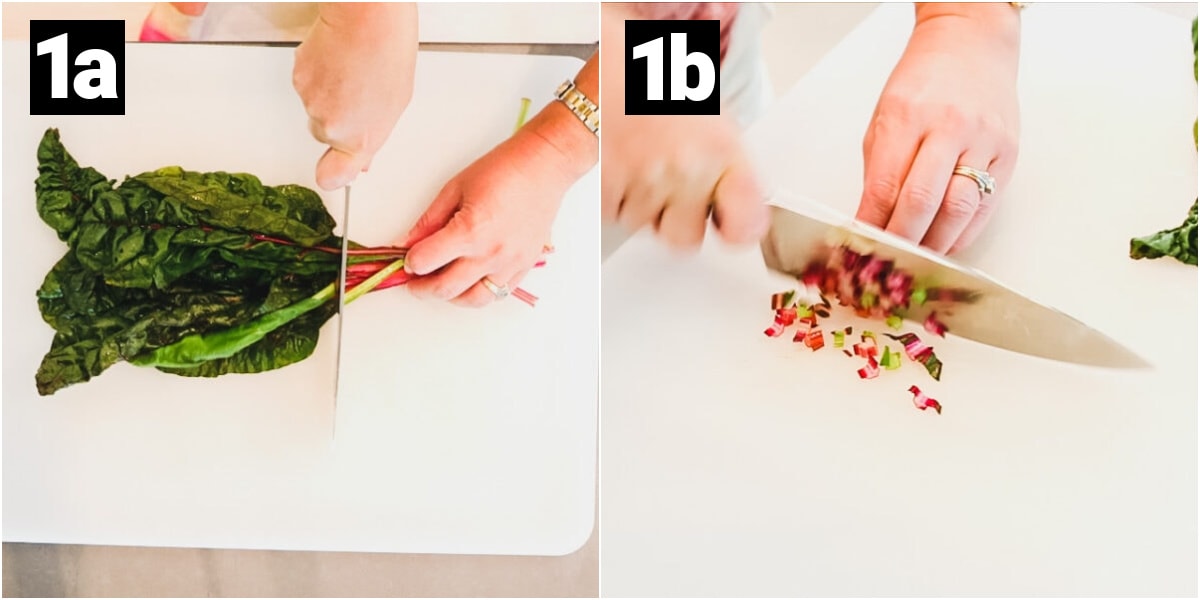
Step 1: Chop and Clean The Swiss Chard
To cut the Swiss Chard, lay a few leaves on top of each other on the cutting board, and remove the colorful stalks. (PHOTO 1a) The Swiss chard stems need to cook for longer than the leaves, so it is important to remove them and cut them separately. Chop up the leaves and place them in a salad spinner. Repeat until you have a stack of stems and a spinner full of greens. Fill the salad spinner with water, swish it around and drain it. If it is a particularly muddy or dirty batch of chard, wash it again. Spin the chard greens dry.
Rinse your stack of stems and trim off the ends if they are dry or discolored. Chop the stems up, just like you would celery. (PHOTO 1B)
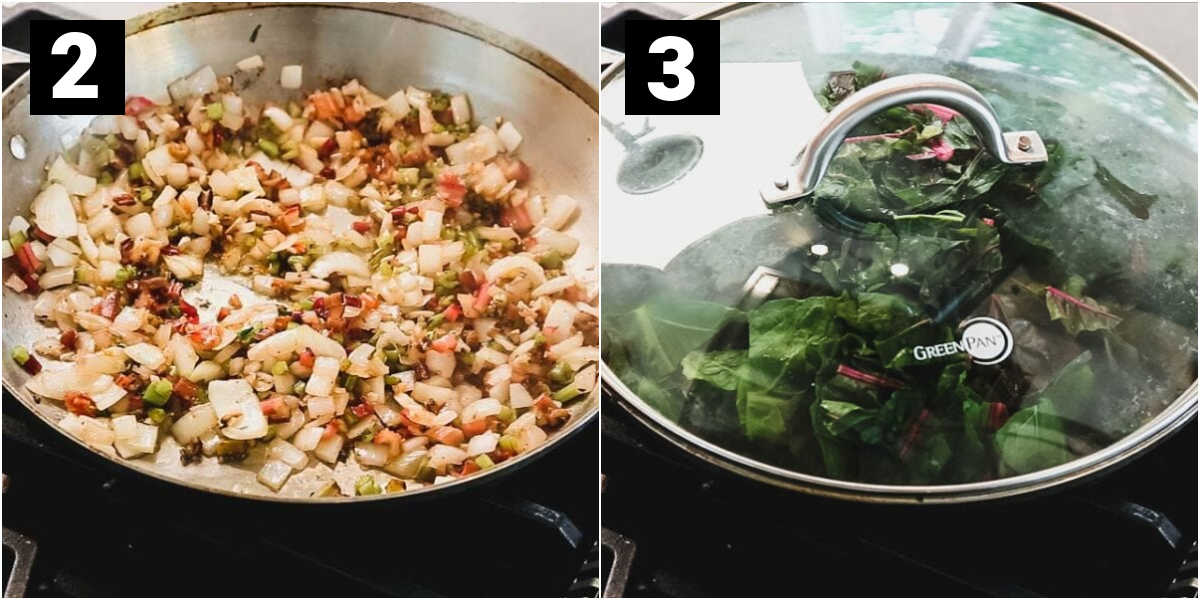
Step 2: Cook The Onions and Chard Stems
Because the stems are high in cellulose you will need to cook them longer than the greens. I love to add flavor and sweetness by cooking the stems with chopped sweet onion. (PHOTO 2) They cook at about the same rate and the onion really balances the bitter flavors of the chard. I also add in the garlic and seasonings at this point to help bloom their flavors.
Step 3: Add Chard Greens, Cover and Wilt
Once the stems and onions are softened and the onions are starting to caramelize a bit, then add the green leaves at the end, since they don’t need as much cooking time to become tender.
To wilt the greens, splash in a couple tablespoons water and cover the skillet with a lid. (PHOTO 3) Note: If you don’t have a very large skillet with a lid you can do this in a wide Dutch oven instead.
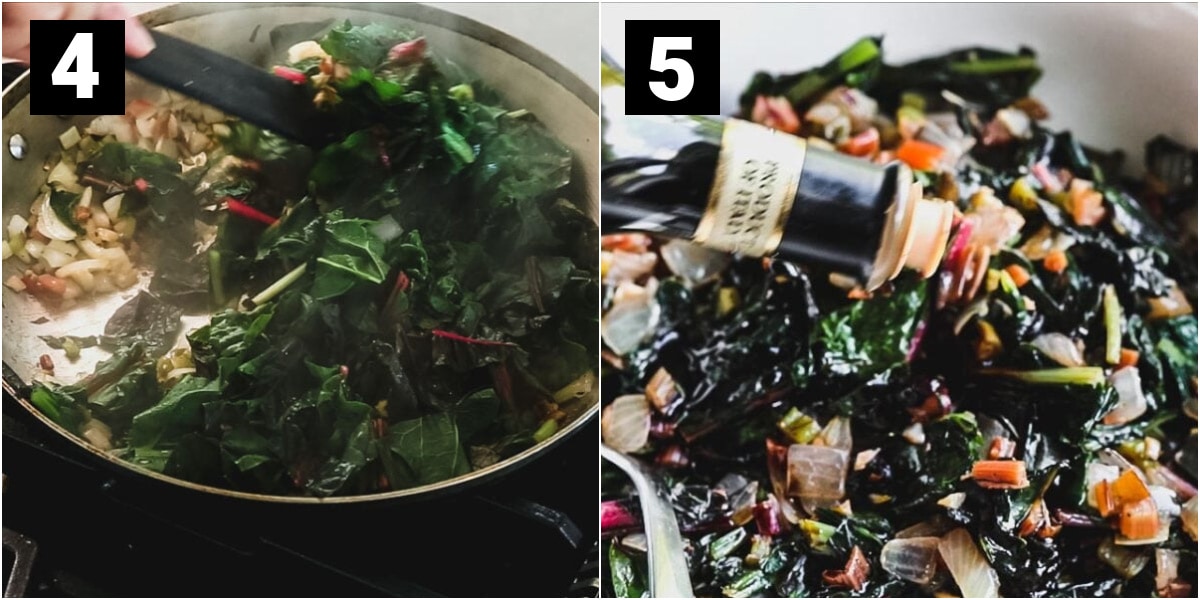
Step 4: Soften Greens
Once the greens are wilted down, remove the lid and continue cooking and stirring until the greens are tender.
Step 5: Finish with Balsamic Vinegar
Remove the skillet from the heat and drizzle on the Balsamic vinegar just before serving.
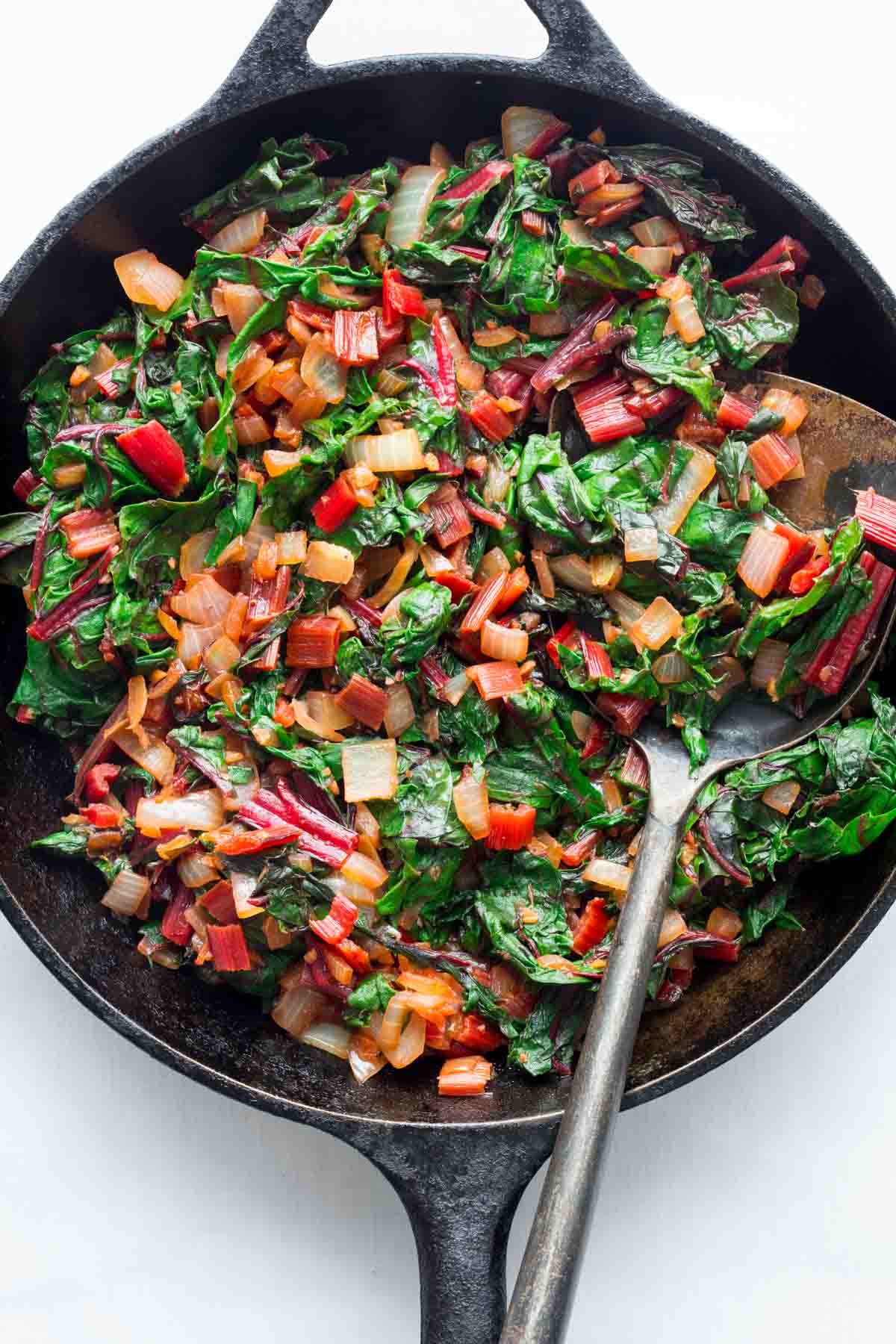
FAQs and Expert Tips
Chard cooks down a lot when you cook it, so I like to make a big batch of it. If you are not sure if you are going to love it, you can cut this simple swiss chard recipe in half. If you do so, keep in mind that the onion mixture in step two will cook a little faster. To double it you’ll need a large heavy bottom soup pot.
A bunch is not a standard measure, so the size will vary. In general, they are about a pound or slightly less for a medium-large bunch. They usually have 5 to 7 stems, and once cut, will yield about 5 to 6 cups of loosely packed chopped leaves plus a cup or more of chopped stems per bunch. While this may not be reassuring if you are bringing in chard from your garden, the good news is that this recipe for swiss chard is incredibly forgiving so no matter how big or small your chard bunch is, it should work fine as written. Or simply adjust the seasonings to your taste preference.
Yes! Having grown Swiss chard in my garden for years I can emphatically say yes chard freezes perfectly. To do so, blanch it in boiling water for 45 seconds. This prevents the enzymes in the vegetable from breaking down the nutrients. Shock the blanched chard in an ice bath and then drain well (I like to do so on a clean dish towel.) Spread out on a large rimmed baking sheet and freeze flat. Once the chard is frozen, transfer it to a resealable freezer bag. Keep frozen for up to four months.
Rainbow chard is not a specific variety of chards but a blend of different varieties planted and harvested together (or sometimes commercially blended after harvesting.) It is a combination of green chard, white seemed chard, yellow and red.
Cooking rainbow chard is no different than cooking a single color but note that red-stemmed Swiss chard does discolor the onions and garlic as it cooks and rainbow chard and green chard do not turn out as reddish. For a bright green sauteé, use only white stemmed chard.
Raw swiss chard looks similar to rhubarb, which is known for having toxic leaves. Unlike rhubarb, Swiss chard stems and leaves are entirely edible. The stems need a little more cooking time than the dark green leaves because they have a lot of cellulose that needs to soften for longer. The leaves cook quickly.
Swiss Chard can be eaten raw, though it contains oxalic acid, so it may be better for you to eat it cooked. Cooking it also makes it less bitter.
This delicious sauteed Swiss chard recipe is loaded with vitamins and minerals and only 80 calories per serving. It is also naturally vegan and only 7 grams net carbs per serving.
Storing Leftovers, Make Ahead, Freezing and Reheating
Leftovers: Keep leftover cooked chard in an air-tight container in the refrigerator for up to three days.
Meal Prep and Prep Ahead Tips: Chop the chard stems and put them in a baggie or small airtight container. Chop and wash the leaves and spin them dry in a salad spinner. Keep them in a Ziplock bag or resealable storage container. Refrigerate up to 5 days (longer if they are really fresh!) The onions can be chopped ahead but they will let off an odor in the fridge so if you are sensitive, wait to chop the onion at the last minute.
Freezing: Cooked chard is great for freezing. Add thawed chard to soups or stews or use for an omelet or to add veggies to pasta dishes.
Reheating: To reheat leftover cooked Swiss chard you can sautee it in a small non-stick skillet over medium heat. Keep covered and add a little olive oil or broth to keep it from sticking if necessary. Stir often and heat through until the Swiss chard is steaming hot, 2-3 minutes. Note, cooked green vegetables turn army green from vinegar, so the leftover chard won’t be vibrant green anymore (but the flavor will still be yummy!)
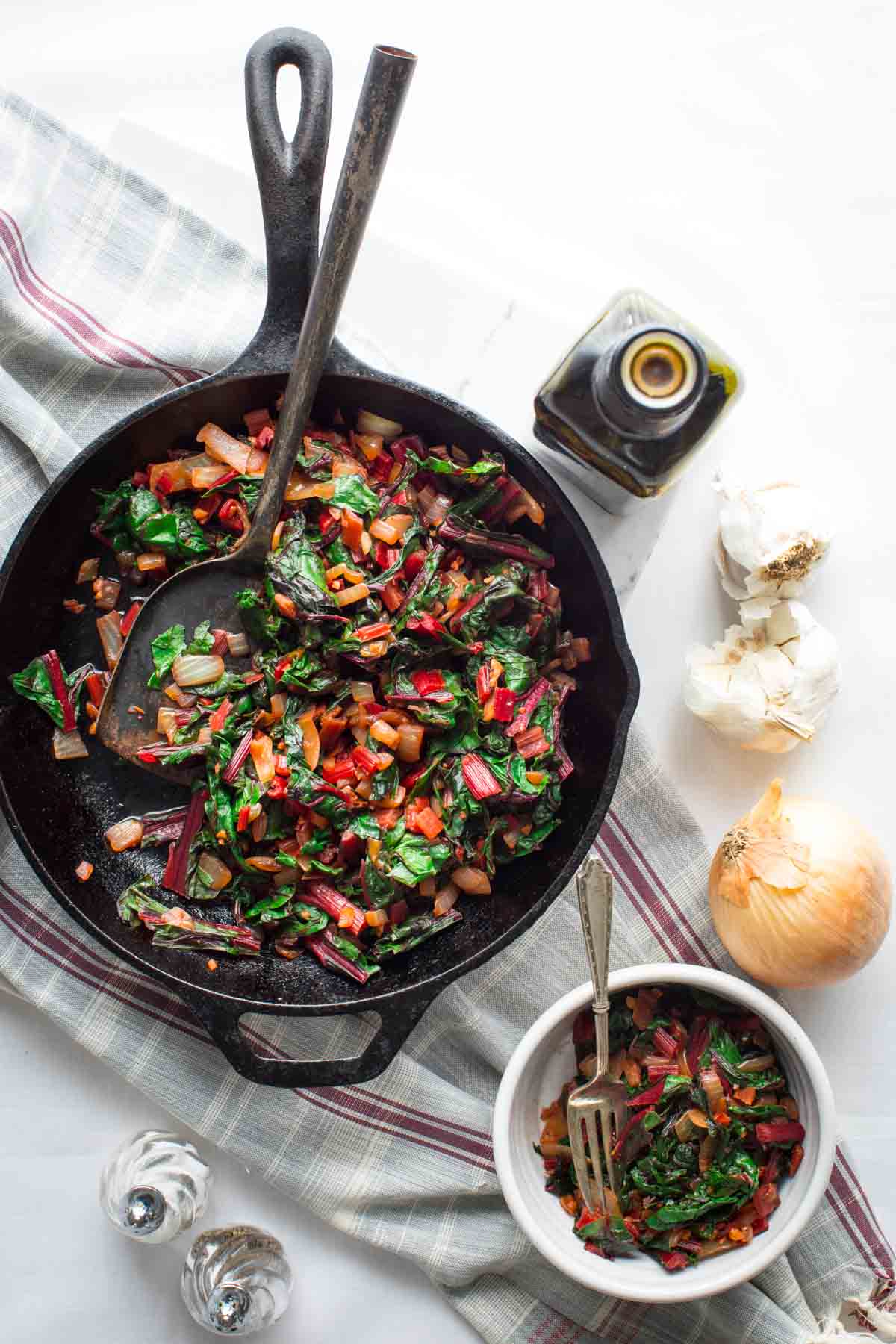
Variations To Try
In this easy side dish recipe, I used aged balsamic to add a balancing tart and sweet note. However, there are lots of other ways to add pizzazz to sauteed Swiss chard.
- Add a handful of toasted almonds or pine nuts, golden raisins, dried cranberries or dried currants, or even a little crumbled feta or goat cheese.
- Fresh herbs can be added as well. Mint goes well with fresh Swiss chard. Add in feta and pine nuts for a pop of great Mediterranean cooking inspiration.
- Instead of Balsamic vinegar, try adding in lemon juice and a little lemon zest at the end.
- Use chopped leeks or shallot instead of garlic and onion
- Blend in 50% kale in place of some of the chard for a kale and chard side dish. Or try beet greens with it!
- Add crumbled cooked Italian sausage or drained canned cannellini beans to this simple sauteed swiss chard recipe for added protein.
- Instead of finishing with balsamic add a splash of cream in the last minute or two of cooking. Once it comes off the heat stir in a generous handful of grated parmesan cheese.
- For spice add a pinch of red pepper flakes with the onion and garlic cloves
What to Serve with this Sauteed Chard Recipe
If you are looking for ways of incorporating this recipe for Swiss chard into your family’s dinner routine, here are some serving suggestions:
- This Balsamic Chicken would be nice or my beloved Turkey Meatloaf recipe.
- I love to pair salmon (and arctic char) with chard. Try this crispy seared salmon, Salmon Baked in Foil or these Lemon Caper Salmon Cakes. Add in my lentils with bacon and you have a five star meal!
- For a weekend meal, try this Crispy Skin Roasted Chicken and Steamed Potatoes with herbs.
- Or for a vegetarian meal, serve this with my pumpkin brown rice risotto.
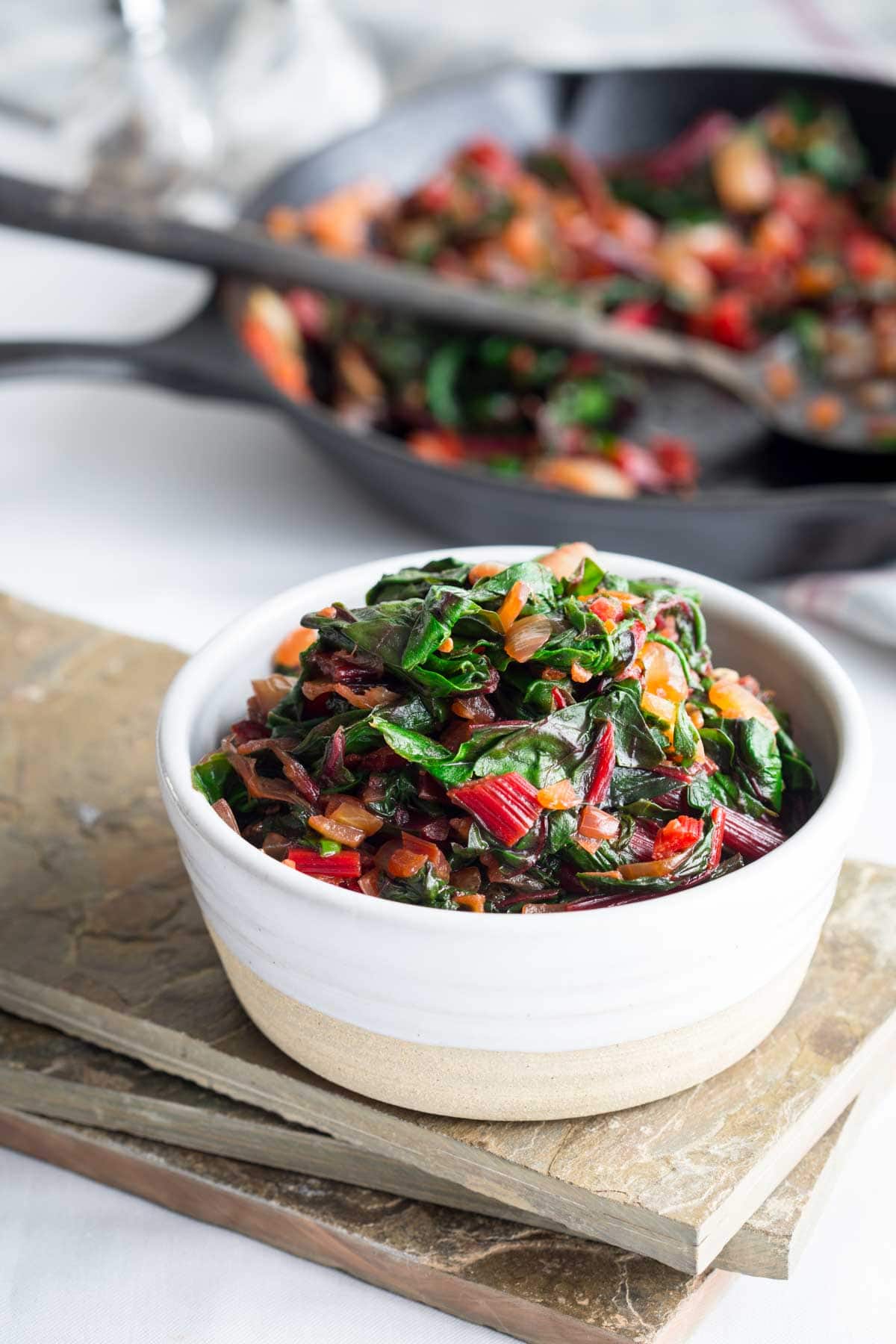
More Easy Swiss Chard Recipes
If you get a CSA share with chard on a regular basis, garden, or just love Swiss Chard as much as me. Here are a few of my favorite healthy ways to cook chard.
- Swiss Chard Pasta is a great vegetarian dinner when fresh chard is in season.
- This Chard Egg Bake is an easy way to use up extra greens and get in your veggies at breakfast!
- Make Spicy Lentil Sausage and Swiss Chard Soup for a chilly evening or to pack for lunches
- I’m so into the flavor combo here: Chard with Chicken and Curry which is made with creamy coconut milk.
- These Bruschetta are topped with Garlicy Greens and savory puree made with white beans and onion.
- Try this Savory Galette with a blend of Swiss chard and cooked greens.
- While baby chard is tender and wonderful eaten raw in a salad and mature Swiss Chard leaves are not as tender so are better when cooked or blended into a swiss chard smoothie.
- The large leaves can also be used to make Swiss Chard Rolls.
- Mature red chard is a favorite when wilted (like kale and spinach) for using in recipes like my Swiss Chard Tart.
- In the winter you can simply stir chopped leaves into soup recipes.
And make sure you check back too! As an avid gardener, I am always coming up with new recipes with Swiss Chard!
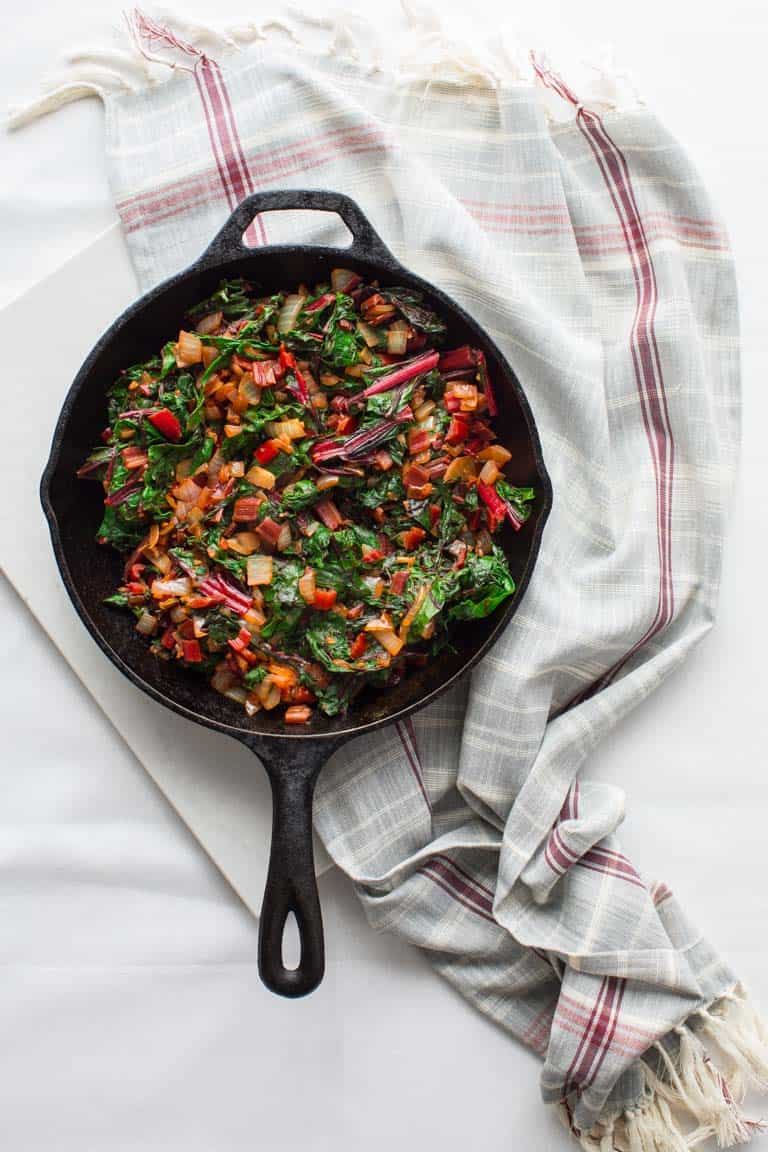
Thanks so much for reading! If you are new here, you may want to sign up for my email newsletter to get a free weekly menu plan and the latest recipes right to your inbox. If you make this recipe, please come back and leave a star rating and review. I would love to hear what you thought!
Happy Cooking! ~Katie
Print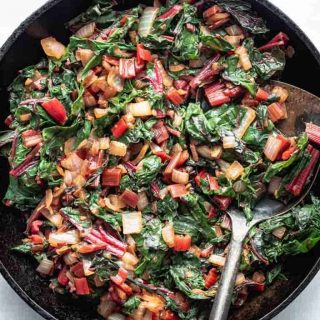
Simple Sautéed Swiss Chard
- Total Time: 20
- Yield: 6 servings 1x
Description
Simple Sautéed Swiss Chard with onions, garlic and a splash of balsamic vinegar. It is a healthy low calorie side dish that’s perfect for beginners!
Ingredients
- 2 large bunches Swiss chard, or rainbow chard
- 2 tablespoons extra-virgin olive oil
- 3 cloves garlic, finely chopped
- 1 large onion, diced
- 1/2 teaspoon salt
- pinch each dry thyme and nutmeg
- Freshly ground pepper to taste
- 2 teaspoons balsamic vinegar, optional
Instructions
- Chop and clean Swiss Chard: Stack several pieces of Swiss chard on work surface. Remove stems and set aside. Roughly cut leaves into pieces about 2-inch square. Repeat with the remaining swiss chard. Transfer the chopped leaves to a salad spinner filled with water. Drain, repeat washing if necessary, and spin dry. Rinse and chop the Swiss chard stems (about the same size as the diced onion.)
- Cook The Swiss Chard Stems with Onions: Heat oil in a large heavy skillet over medium high heat. Add chopped chard stems, garlic, onion, salt, thyme, nutmeg and pepper and cook, stirring often until the onions are starting to brown, 6 to 8 minutes.
- Add The Leaves and Wilt: Add chopped cleaned Swiss chard leaves, 2 tablespoons water and cover. Let wilt, 2 to 4 minutes.
- Cook Until Softened: Remove lid and continue cooking, stirring occasionally until the Swiss chard is completely wilted and softened, 1 to 3 minutes.
- To Finish and Serve: Remove from the heat and drizzle with balsamic vinegar if using. Serve hot.
Notes
Alternative To Large Skillet with Lid: If you don’t have a very large skillet with a lid you can do this in a wide Dutch oven instead.
Other Elements To Try Adding To This Recipe:
If you’re ready to get creative with this recipe here are some idea starters for ways to liven up this recipe even more!
- Add a handful of toasted almonds or pine nuts at the end.
- When you remove the lid add a handful of golden raisins, dried cranberries or dried currants
- When you pull it off the heat crumble on a little feta or goat cheese.
- Fresh herbs can be added as well. Savory woody herbs like oregano or thyme can go in with the onions, where as tender herbs like mint, basil or chives can be stirred in after it comes off the heat.
- Prep Time: 10
- Cook Time: 10
- Category: side dish
- Method: stove top
- Cuisine: American
Nutrition
- Serving Size: 2/3 cup
- Calories: 80
- Sugar: 5 g
- Fat: 5 g
- Carbohydrates: 9 g
- Fiber: 2 g
- Protein: 2 g

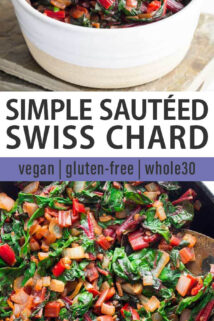
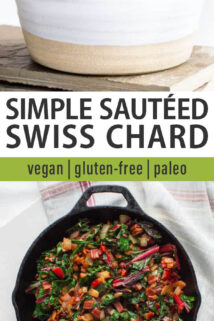
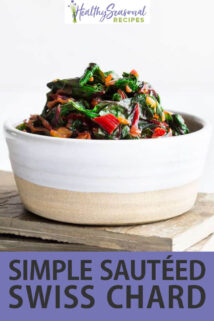
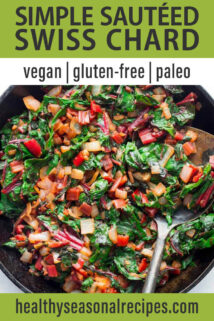
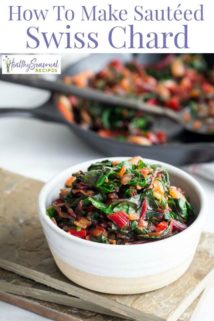
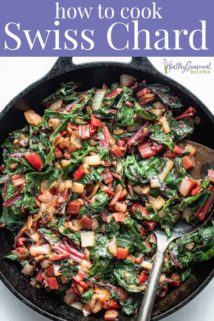


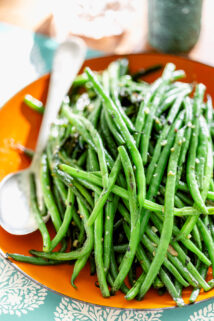

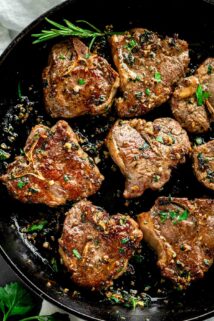
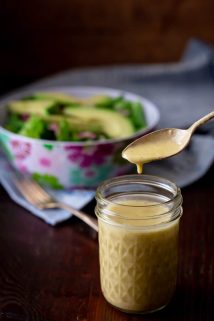





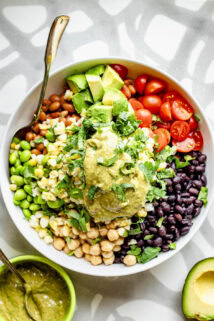
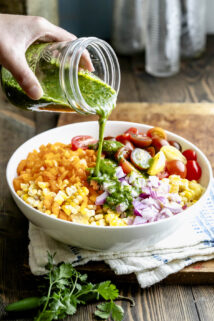
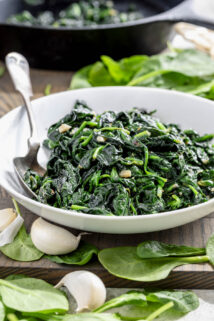
I bought Swiss chard at my local farmer’s market and had no idea what to do with it. All I knew was that I liked how it looked and was certain it would be nutritious. Well, this recipe is a winner! Simple, clean and delicious! Will definitely add this to my rotation. Thank you!!
Easy, delicious and healthy! What more can you ask?
Love this review Kathleen! Thanks so much!
We love this recipe! We grow Swiss chard in our garden and this is perfect. Thanks!
Wow, I made the recipe just as directed, I added sautéed portobello mushrooms and it was amazing!
I made this last night after bringing home a HUGE bunch of rainbow chard. It’s delicious!
I ended up adding more balsamic vinegar at the table, just personal preference. Definitely a keeper recipe! Thank you!
This is a great recipe! I love Swiss chard and this recipe makes it so easy and delicious.
Thanks for this recipe Katie! Another great thing about Swiss Chard is it is SO easy to grow at home. I have just clipped the first few leaves and stems fro a line of chard that I planted in August, and boy was it a great addition to this evening’s meal. You know when the side dish takes center stage on the plate instead of the main? Well here you have a side that does that! Thanks again, Bruce
I followed the recipe to a tee! I served it over cauliflower rice…Absolutely delicious! My husband and I loved it!
Sounds yummy! Thanks so much!
We made this recipe with just onions and the chard. Did not have fresh garlic on hand and decided we did not need the balsamic. It was delicious with just the onions and the chard. Thank you for providing such clear instructions for preparing the stems and leaves and for making it straightforward!
Thanks Virginia. I am glad to hear you liked it. Thank you for coming back by the blog to let me know how it turned out. That is always appreciated. Have a great week.
This was so good!. Threw in cranberries and used my cranberry balsamic vinegar. Used up some giant chard from the garden and my 8 and 7 year old grands loved helping make it and eat it.
Reading good recipes. I love swiss chard
Can this be made in advance to take as a side dish for a pitch in / party side? If so, serve cold or reheat somehow?
Yes, but I want to point out that it only makes about 3 1/2 cups of cooked greens -which may look like a visually meager amount to bring as a dish to share. I’d suggest that you will want to make a couple of batches if you are planning to bring it as a sharing dish. (Or a batch and a half- 3 bu of greens.) I actually like cooked greens served at room temp, you could serve it on a platter with some extra virgin olive oil drizzled over it with a little crumbled feta. Instead of aged balsamic, a balsamic drizzle would be better since it is thicker. Serve it with small tongs. If that sounds a little strange to you then by all means you can definitely reheat it (on the stove or microwave is best)- I would wait to add the balsamic afterwards.
To clarify I mean balsamic glaze – they’re with the vinegars in most grocery stores, and are meant to finish the dish.
I had Swiss chard in the refrigerator with no direction until I opened up your weekly email this morning. This dish has fantastic flavoring. I was a little off on my Swiss chard to onion ratio, but it was good anyways. I added a can of drained beans and the balsamic vinegar. This is a keeper!
Sounds delish. I make mine similarly but I use a bit of hot sauce (to taste) and fresh organic lemon juice, EVOO, and fresh garlic